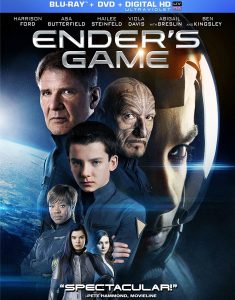Writer-director Gavin Hood, best known for helming 2009’s “X-Men Origins: Wolverine,” does a wonderfully faithful job of adapting Orson Scott Card’s 1985 sci-fi masterpiece “Ender’s Game” to the big screen while also keeping things entertaining. It’s been awhile since I read the book, but the film seems to hit all the same beats and themes, and it tackles the one major adaptation hurdle — the fact that the characters are 6 years old — by making them just a bit older.
In the film, the characters are tweens rather than young children, but I think one of the central themes holds up: This future Earth government uses kids to fight its high-tech, drone-powered offensive against the Formics, alien bugs who attacked once and were driven off. Under Earth law, it used to be a war crime to recruit kids younger than 15, but the rules changed when the Formics first attacked.
The mere fact that children fight in the Human-Formic war illustrates the immorality of war quite nicely, and as a bonus, the Battle School serves as a timeless metaphor for public school, since Ender Wiggin has to fight off bullies and learn other coping strategies. Oddly, in one regard the Battle School of “Ender’s Game” is more forward-thinking than current public schooling because it teaches the kids HOW to think rather than WHAT to think. But there’s a caveat: Only when it comes to military tactics. Writing in 1985, Card ingeniously predicted the melding of video games and war technology.
And, as fans of the vast, multi-book Ender saga know, Battle School is one of two central themes. The other is that Ender is extremely empathetic: Taking traits from both his violent brother, Peter, and his peaceful sister, Valentine, Ender is able to defeat opponents — in fistfights, war games and remote drone warfare — because he gets to know them so well, and by knowing them well, he always loves them. Hood does a nice job of peppering this tragic undertone throughout the film, and Ender actor Asa Butterfield sells it with some nice watery-eyed scenes.
The cast is how I pictured them, except that I thought Bean would be a bit smaller. As it is, actor Aramis Knight seems to be about the same size as Butterfield. Abigail Breslin is exactly how I pictured Valentine, Hailee Steinfeld works as Ender’s slightly older friend Petra while still having childlike traits, Harrison Ford strikes the right balance of military man and caring adult as Colonel Graff, and Ben Kingsley is a spot-on Mazer Rackham. The battle room — housed in a clear sphere that looks out into space — where the war games are played exceeded by imagination, while the Mind Game is about what I expected.
The film ends with Ender planning to make up for his near-xenocide of the Formics by journeying throughout the stars. Interestingly, although Hood is seemingly setting up a sequel and although “Ender’s Game” is no doubt making enough money to warrant one, Card couldn’t have made his saga less movie-sequel-friendly if he’d tried. The Battle School saga continues in the “Ender’s Shadow” series, but without Ender. And the exploration of Ender’s empathy for all living beings continues with “Speaker for the Dead” and other books, but — due to the nature of space travel — Ender is an adult there (Plus, if memory serves, that series does not scream for the big-screen treatment; it’s more literary).

So the filmmakers, if they want to continue being faithful to Card’s books, have the weird prospect of a sequel that 1) features none of the actors from the original and jumps ahead to a 35-year-old Ender, or 2) features a lot of the same actors, but not Ender. “Ender’s Shadow” would have Ender in the background, but it’s extremely unlikely they’d adapt that one, as it’s the same story as “Ender’s Game,” just from Bean’s point of view — very much a literary exercise.
Perhaps Hood is scratching his head right now trying to decide on a strategy. But in the meantime, he can be proud of respectfully bringing “Ender’s Game” to the big screen.

